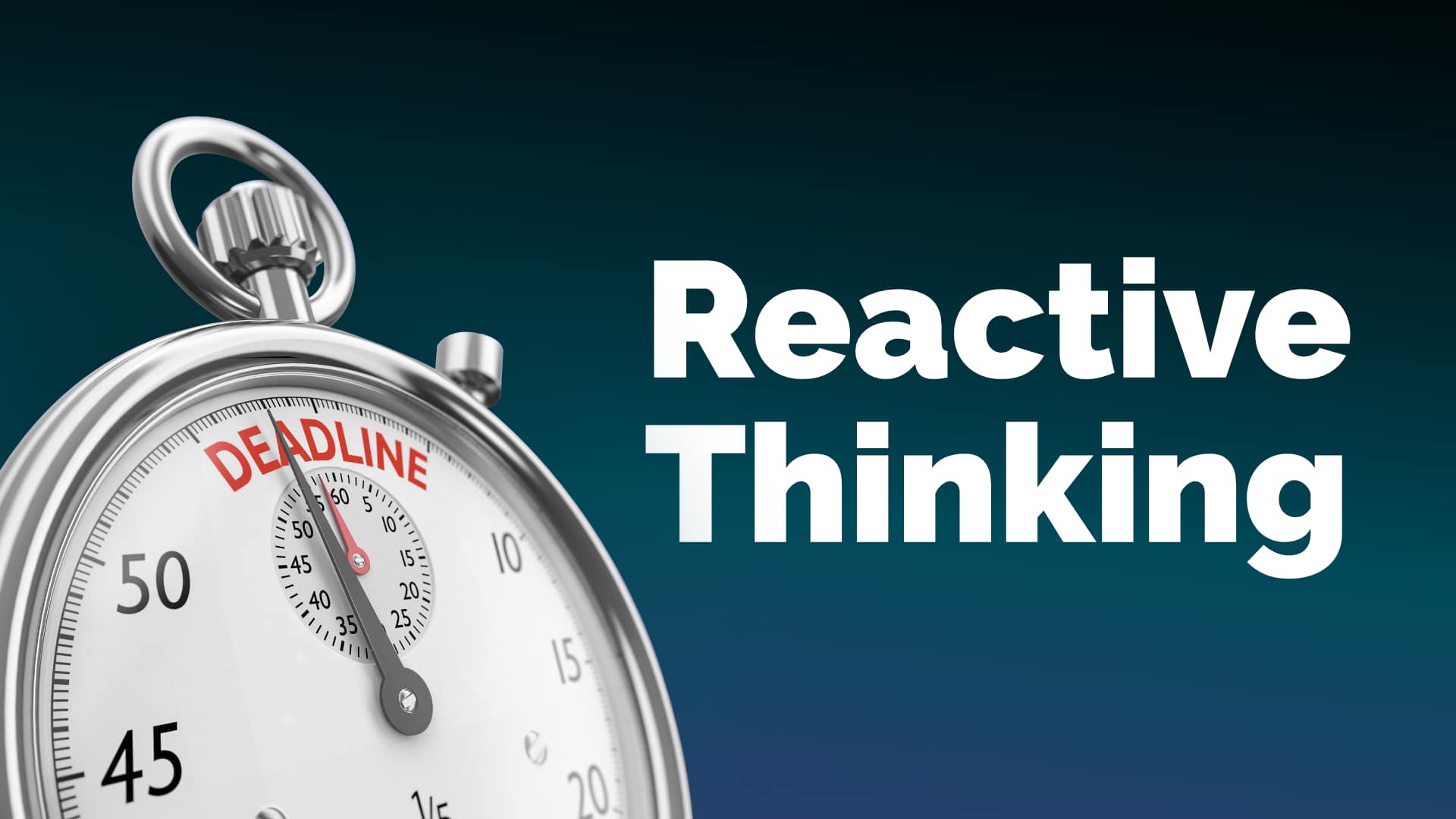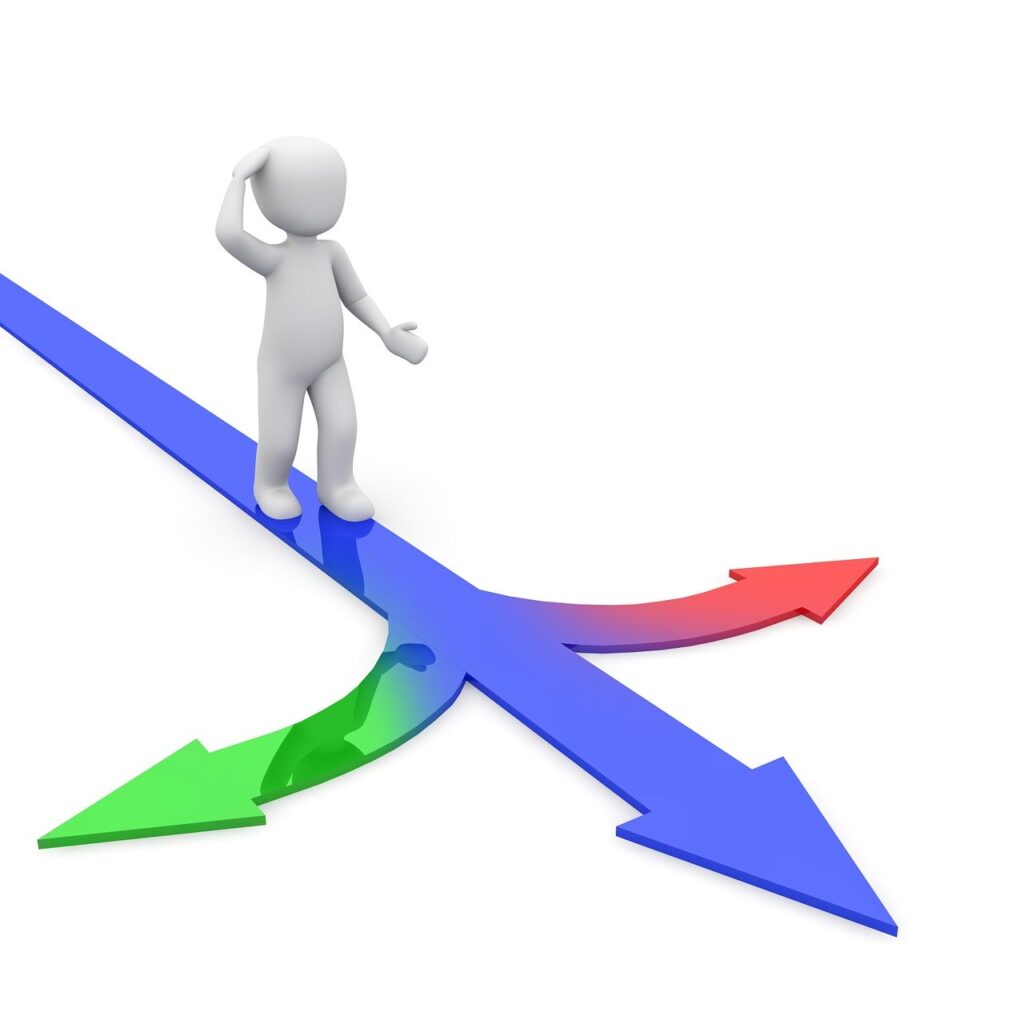September 11, 2024
Reactive Thinking – A Must Avoid When Making Important Decisions

As human beings, we’re biologically, developmentally and socially designed to react – it’s what helps us survive in the world. For instance, in traffic we react to what’s happening in front of us. If the car ahead is too close, we slow down, if it stops, we stop. It’s our ability to react that keeps us alive and safe, rendering it a hugely important mechanism in our lives.
Think about your childhood. Did you grow up hearing repeated messages from parents and teachers about how you should and shouldn’t behave; what you should and shouldn’t do? For the majority of us this was definitely the case. As children our mistakes are often pounced on quickly, but few of us are told with any regularity that we’re smart or creative. Unsurprisingly, once we reach adulthood our normal mode of thinking focuses on avoiding mistakes, solving problems as quickly as possible and being responsive. In other words, we’re conditioned to be reactive thinkers.

Ninety-nine hundredths or, possibly, nine hundred and ninety-nine thousandths of our activity is automatic and habitual, from our rising in the morning to our lying down each night.
William James, American philosopher and psychologist
We engage in reactive thinking when we react to events, tasks or external influences in pre-programmed ways. Most of the time, this mode of thinking serves a really useful purpose as our ‘autopilot’, helping us make practical shortcuts as we journey through the patterns of life. Learning a new task such as how to use a new computer system or piece of machinery requires applied focus and concentration. Once we’re skilled at the task however, we don’t have to rethink the process every time we come to do it – it becomes automatic. This makes reactive thinking great for helping us perform the regular and commonplace activities in our lives more quickly, freeing up valuable time for other things.
How Fast Can You React?
In business today, a huge emphasis is placed on fast reactions i.e. the ability to respond quickly to anything that comes up. When something occurs or is put in front of us – a threat, an opportunity, even an email – we rush to deal with it effectively in a short space of time. In order to respond quickly, we make our decisions intuitively. We’ll look to our previous experiences as a pre-conceived set of indicators to determine a course of action without wasting time planning or weighing up alternatives.
Life is 10 percent what happens to you and 90 percent how you respond to it.
Lou Holtz, American football coach
There’s nothing wrong with this. This type of reactive functioning is useful, efficient and makes a powerful contribution to our day-to-day productivity. A lawyer thinks in this way while working on a standard case and a doctor will rapidly diagnose and treat a queue of patients with great success. Under predictable conditions, this mode of thinking is extremely valuable, conserving our time and energy and helping us tackle business situations where there’s high time pressure.
While no one can deny that swift action is very often necessary in business, speed does present some hazards. Consider the following question:
Q) If you were running a marathon, how effective do you think you’d be if you spent most of it sprinting?

Unless you possess incredible, super-athletic powers, you’re probably going to burn out pretty quickly! The same applies in business – if you focus all your energy contending with short-term challenges or crises, before too long your productivity will plummet. Speed is important at certain times but at the wrong times it’s a massive inhibitor. If at the beginning you don’t take the time to strategise where you’re going and how you’re going to get there, you might even end up heading the wrong way!
Business is a marathon, not a sprint. As helpful as it is to take practical and speedy shortcuts, they can obstruct our performance in the long run. Just because a familiar strategy or approach has worked in the past, it doesn’t mean it will work in the future! The one constant in business is change. When we’re reactive we risk overlooking valuable opportunities to be creative in a fluctuating environment because we’re too busy swiftly executing what’s always worked before. It makes sense that we would fare far better by pacing ourselves to engage our thinking in activities that will help us evolve and progress, for example:
- To achieve something we haven’t done before.
- To do something better than we did it last time.
- To find a more effective way of doing something that we’re used to doing routinely.
This latter approach is proactive thinking. When we react we’re sprinting, when we’re proactive we’re running a marathon.
Letting Events Take Control
There is a time when we must firmly choose the course we will follow, or the relentless drift of events will make the decision.
Franklin D. Roosevelt, 32nd President of the United States
When we react quickly to an event but don’t have a clear grasp of the whole picture, we’re not necessarily going to reach our destination quicker. In reality, we may end up with a different result than we wanted and have to react quickly again to get back on track. This is because we’re operating in crisis-based mode where each new occurrence, opportunity or problem catches us by surprise and ends up setting the agenda for where we’re going.
However, if we were to view our situation from a higher perspective beforehand, we could consciously engineer our own outcomes by setting our goals and implementing a precise strategy to achieve those goals. Instead of reacting to events and waiting for opportunities, we could create our own events and opportunities. What’s more, we might even anticipate any problems or events before they occurred and have contingencies in place to deal with them. In other words, we could be proactive.
When we’re predominantly reactive, we spend most of our time trying to fix minor problems and eliminate external threats due to the classic ‘fight-or-flight’ response. We’re also prone to have a short-term, tactical approach and will do things in a predictable way the majority of the time, persistently reinforcing the status quo. This can bring a certain degree of success as business is about managing risks and sustaining good practice. But when we follow this sort of pattern all the time it becomes difficult to implement innovation in any planned way as our energy and resources are tied up in reacting to what others are doing in a typical ‘me too’ fashion. From this ‘follower’ position, we can experience a severe decline in our ability to innovate as we become trapped in a never-ending problem-reaction loop.
Are you Reacting or Creating?
In business, people typically start the decision making process by brainstorming in groups – management teams, boards of directors, product development teams and so on. In an Arthur Andersen survey conducted in 2000, more than 70 per cent of business people said they use brainstorming in their organisations. Interestingly, in all the years that I’ve worked with creative companies and people, I’ve discovered that many become frustrated by the sheer number of failed brainstorming sessions they have. These sessions fail for a very simple reason – because the participants are not actually brainstorming… they just think they are.

Let’s look at the dynamics that take place when a group of people get together to brainstorm for solutions to a particular business challenge.
What usually happens when one person throws out an idea?…
…Almost immediately, the other members of the group analyse and judge it (silently or openly), and the response in their minds will typically be one of the following:
I agree with the idea and will do everything I can to back it up. I disagree with the idea so I’m going to do everything I can to make sure it doesn’t happen. Maybe, I’ll keep listening and give the idea some thought.
From the outset, these members of the group are being reactive – in their minds, they’ve already decided and set off down a certain path. They’ve used analytical thinking to pass judgement on the idea with the result that they accept it, consider it, or reject it. In doing this they’ve been distracted from their main purpose of idea generation.
So if being reactive is the predominant thinking mode in the group, can they actually be said to be brainstorming?
Clearly not. By stopping to analyse and evaluate the idea, the group isn’t in the right mindset to be generative. They’re criticising instead of creating. Their reactive thinking has caused them to fall into a trap. While judgement and analysis play a critical role in decision making, they’re hopeless at coming up with creative solutions to problems. As Edward de Bono says, “Six brilliantly trained critical thinkers sitting around a table cannot get going until someone actually puts forward a constructive proposal.”
Decision Making Machines
In life and in business you could say that, ultimately, we’re all decision making machines. Decision making is at the core of everything we do, whether it’s planning, organising, implementing or managing. Even deciding not to decide is a decision!
We make decisions based on our mindset at that particular time. A lot of the time we feel pressure to get things sorted quickly and will adopt a short-term, reactive view to be efficient. This isn’t always bad – being reactive can be very positive at times where quick thinking is needed to get us back on track. But when we fall back on it all the time, it’s easy to get stuck in a loop of solving the same type of problem over and over again. It then becomes difficult to enact any real innovative change. This is because we’re looking at things with a worm’s eye view when we need to start with a bird’s eye view.

Innovative thinking should be proactive first and reactive second, whenever possible. To be proactive demands a more conscious effort from us as we’re habitually ingrained to be reactive. Once a strategy is in place, reactive thinking can become more meaningful and rational when put into service to help us on the day-to-day journey to reach our goals. It provides the backbone for our actions so we can be confident that we’re reacting in the right way.
